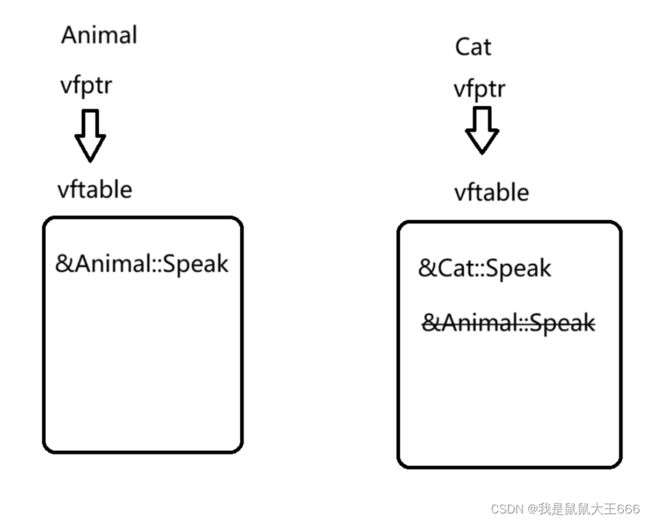C++核心编程(黑马笔记)
C++核心编程(面向对象)
内存分区模型
C++执行时,内存大方向划分为4个区域
- 代码区:存放函数体的二进制代码,由操作系统管理
- 全局区:存放全局变量和静态变量以及常量
- 栈区:由编译器自动分配释放,存放函数的参数值,局部变量等
- 堆区:由程序员分配和释放,如果程序员不释放,程序结束时由操作系统回收
程序运行前
程序编译后,生成了exe,未执行程序前
代码区:
存放CPU执行的机器指令
**特点:**共享的:频繁执行代码,只需保存一份
只读的:防止程序意外修改
全局区:
存放全局变量和静态变量
包含常量区:存放字符串常量和其他常量
该区域的数据在程序结束后被操作系统释放
示例:
#include 程序运行后
栈区:
编译器自动分配释放,存放函数的参数值,局部变量等
注意:不要返回局部变量的地址,栈区开辟的数据由编译器自动释放
示例:
# include 注意 VS2022(64位)地址一直保留
堆区:
由程序员分配和释放,如果程序员不释放,程序结束时由操作系统回收
主要利用new在堆区开辟内存
示例:
# include new
new操作符在堆区开辟数据- 手动释放使用
delete - new的数据返回对应类型的指针
示例:
# include 引用
基本使用
- 给变量起别名
数据类型 &别名 = 原名- 引用必须初始化
- 一旦初始化,就不可更改
示例:
# include 函数
-
引用做函数参数
-
引用做函数返回值
-
不要返回局部变量的引用
-
函数的调用可以作为左值
示例:
# include 本质
本质上是指针常量
int& ref = a 相当于 int* const ref = &a
ref = 20 相当于 *ref = 20
常量引用
**作用:**常量引用主要用来修饰形参,防止误操作
在函数形参列表中,可以加const修饰形参,防止形参改变实参
示例:
# include 函数高级
默认参数
语法:返回值类型 函数名 (参数 默认值)
注意:
- 如果某个位置有了默认参数,从这个位置往后,从左往右都必须有默认值
- 函数声明有了默认参数,函数实现不能有默认参数(只能有一个有默认参数)
示例:
# include 占位参数
语法:返回值类型 函数名 (数据类型){}
示例:
# include 函数重载
**作用:**函数名可以相同,提高复用性
满足条件:
- 同一个作用域
- 函数名称相同
- 函数参数类型不同或者个数不同或者顺序不同
**注意:**函数重载的返回值不可以作为函数重载的条件
示例:
# include 注意事项:
# include 类和对象
封装
意义:
- 将属性和行为作为一个整体
- 将属性和行为加以权限控制
示例:
# include 访问权限:
| public | 类内可以访问 | 类外可以访问 | |
|---|---|---|---|
| protected | 类内可以访问 | 类外不可访问 | 可以访问父类的保护内容 |
| private | 类内可以访问 | 类外不可访问 | 不可以访问父类的私有内容 |
示例:
# include struct与class的区别:
- struct默认为public
- class默认为private
成员属性设置为私有:
- 自己控制读写权限
- 检测数据有效性
示例:
# include 对象的初始化和清理
构造函数和析构函数:
- 构造函数:创建对象时为对象的成员赋值,由编译器自动调用
- 析构函数:对象销毁前系统自动调用,执行清理工作
我们不提供析构和构造的话,编译器提供的是空实现。
构造函数语法:类名(){}
析构函数语法:~类名(){}
相同点:
- 没有返回值也不写void
- 函数名称与类名相同
- 无需手动调用,并且只会调用一次
不同点:
- 构造函数可以有参数,可以发生重载
- 析构函数不可以有参数,不可以发生重载
# include 构造函数的分类和调用:
两种分类方式:
- 参数:有参构造和无参构造
- 类型:普通构造和拷贝构造
三种调用方式:
- 括号法
- 显示法
- 隐式转换法
# include 拷贝构造函数的调用时机:
三种情况:
- 使用一个已经创建完毕的对象来初始化一个新对象
- 值传递的方式给函数参数传值
- 值方式返回局部对象
# include 构造函数调用规则:
默认情况下,C++编译器至少给一个类添加3个函数
- 默认构造函数(无参,函数体为空)
- 默认析构函数(无参,函数体为空)
- 默认拷贝构造函数,拷贝属性值
调用规则:
- 如果用户定义有参构造函数,C++不在提供默认无参构造,但是会提供默认拷贝构造
- 如果用户定义拷贝构造函数,C++不会再提供其他构造函数
# include 深拷贝与浅拷贝:
- 浅拷贝:简单赋值拷贝操作
- 深拷贝:堆区重新申请空间,进行拷贝
# include 初始化列表:
语法:构造函数(): 属性1(值1),属性2(值2) ...{}
# include 对象成员:
class A {}
class B {
A a;
}
示例:顺序:手机构造->人构造->人析构->手机析构
# include 静态成员:
静态成员变量:
- 所有对象共享一份数据
- 编译阶段分配内存
- 类内声明,类外初始化
静态成员函数:
- 所有对象共享同一个函数
- 只能访问静态成员变量
示例1:
# include 示例2:
# include C++对象模型和this指针
成员变量和成员函数分开存储:
# include this指针:
this指针指向被调用的成员函数所属的对象
this指针是隐含每一个非静态成员函数内的一种指针
this指针不需要定义,直接使用即可
用途:
- 形参和成员变量同名时,可用this指针区分
- 在类的非静态成员函数中返回对象本身,可使用return *this
# include 空指针访问成员函数:
# include const修饰成员函数:
常函数:
- 成员函数后加const
- 不可以修改成员属性
- 加关键字mutable后,在常函数中可以修改
常对象:
- 声明对象前加const
- 只能调用常函数
# include 友元
目的:让一个函数或者类访问另一个类中私有成员
关键字:friend
三种实现:
- 全局函数
- 类
- 成员函数
全局函数:
# include 类:
# include 成员函数:
# include 运算符重载
加法:
# include 左移:
# include 递增:
# include 赋值:
# include 关系:
# include 函数调用:
# include 继承
继承的目的:减少重复的代码
语法:class 子类 : 继承方式 父类
- 子类也称为派生类
- 父类也称为基类
# include 继承方式:
# include 对象模型:
父类中的所有非静态成员属性都会被子类继承下去
# include 继承中构造和析构的顺序:
构造和析构的顺序:先进后出
同名成员处理:
- 子类对象可以直接访问子类中的同名成员
- 子类对象加作用域可以访问到父类同名成员
- 当子类与父类拥有同名的成员函数,子类会隐藏父类中同名成员函数,加作用域可以访问到父类中同名函数
# include # include 多继承:
语法:class 子类 : 继承方式 父类1 , 继承方式 父类2...
不建议使用
# include 总结:
- 菱形继承的问题是子类继承两份相同数据,资源浪费
- 利用虚继承解决菱形继承问题
多态
基本概念:
多态分为两类:
- 静态多态:函数重载和运算符重载
- 动态多态:派生类和虚函数实现
区别:
- 静态多态的函数地址早绑定 - 编译阶段确定函数地址
- 动态多态的函数地址晚绑定 - 运行阶段确定函数地址
# include 动态多态满足条件:
- 有继承关系
- 子类重写父类的虚函数
动态多态使用:父类指针或引用 执行子类对象
原理:
纯虚函数和抽象类:
纯虚函数语法:virtual 返回值类型 函数名 (参数列表) = 0
当类中有了纯虚函数,这个类也称为抽象类
抽象类特点:
- 无法实例化对象
- 子类必须重写抽象类中的纯虚函数,否则也属于抽象类
# include 虚析构和纯虚析构:
多态使用时,如果子类中有属性开辟到堆区,那么父类指针在释放时无法调用到子类的析构代码
解决方式:父类中的析构函数改为虚析构和纯虚析构
虚析构和纯虚析构共性:
- 可以解决父类指针释放子类对象
- 都需要有具体函数实现
虚析构和纯虚析构区别:
- 纯虚析构,属于抽象类,无法实例化对象
虚析构:virtual ~类名(){}
纯虚析构:virtual ~类名() = 0 类名::~类名(){}
# include 总结:
- 虚析构或纯虚析构就是用来解决通过父类指针释放子类对象
- 如果子类中没有堆区数据,可以不写虚析构或纯虚析构
- 拥有纯虚析构函数的类也属于抽象类
文件操作
对文件进行操作需要包含头文件
文件类型:
- 文本文件
- 二进制文件
操作文件的三大类:
ofstream:写ifstream:读fstream:读写
文本文件
写文件:
1.包含头文件
2.创建流对象
3.打开文件
4.写数据
5.关闭文件
| 打开方式 | 解释 |
|---|---|
ios::in |
目的是读文件 |
ios::out |
目的是写文件 |
ios::ate |
初始位置:文件尾 |
ios::app |
追加方式写文件 |
ios::trunc |
文件存在先删除,再创建 |
ios::binary |
二进制 |
# include 读文件:
# include 二进制文件
打开方式指定:ios::binary
写文件:
调用成员函数write
函数原型:ostream& write(const char * buffer, int len)
解释:buffer->内存中一段存储空间 len是读写的字节数
# include 读文件:
调用成员函数read
函数原型:istream& read(char * buffer, int len)
解释:buffer->内存中一段存储空间 len是读写的字节数
# include 




